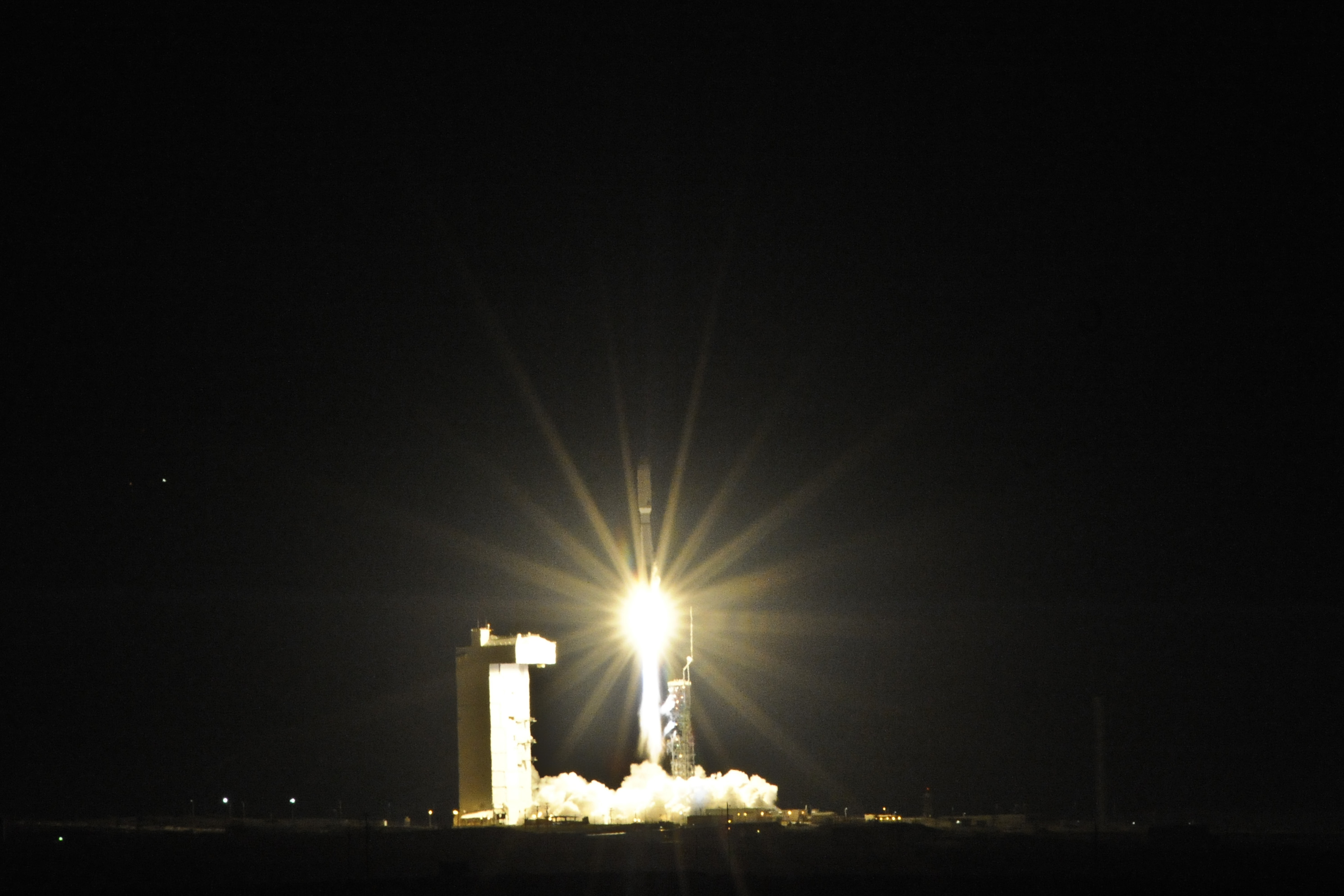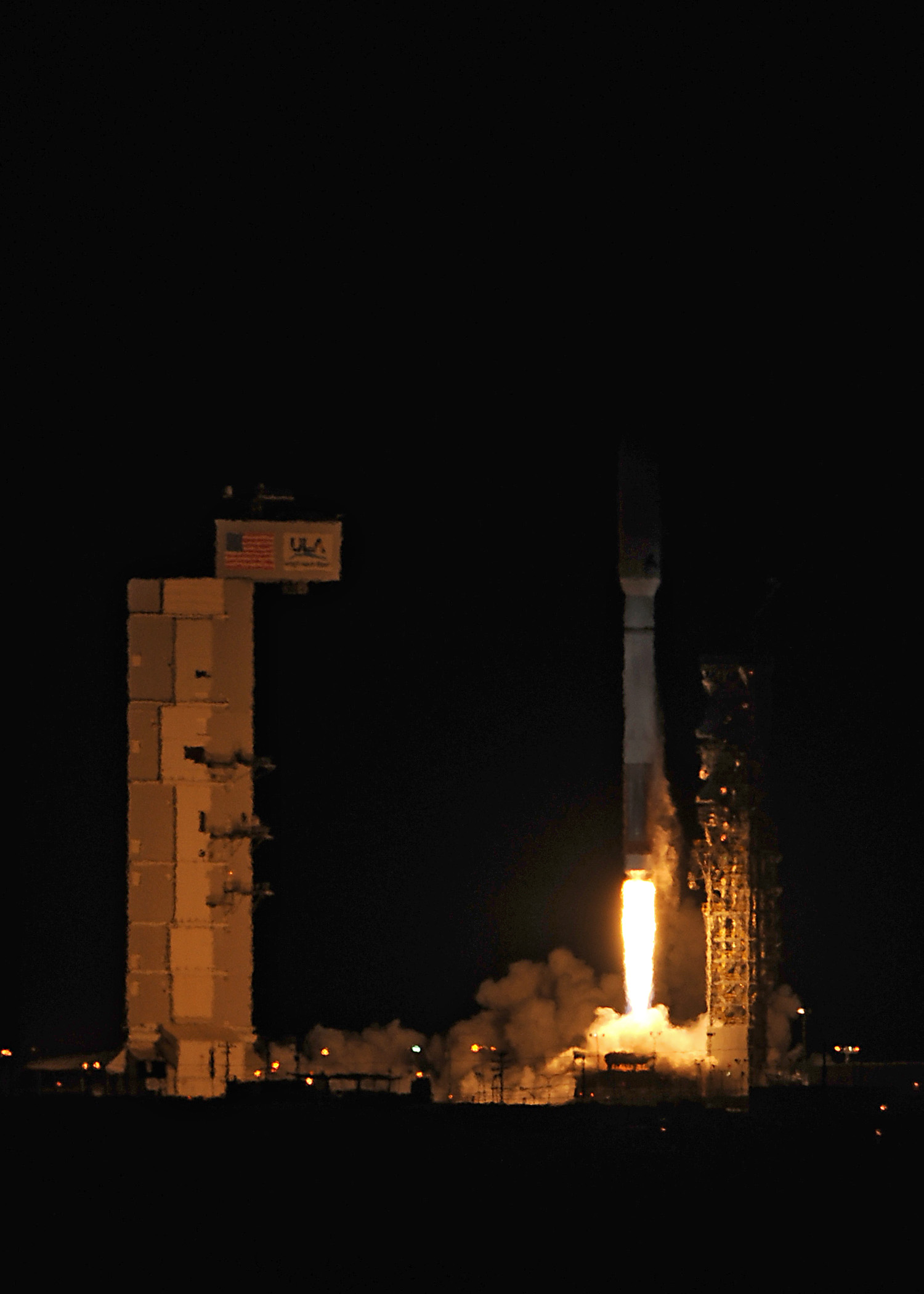Top-Secret US Spy Satellite Launches into Orbit (Photos)

A classified U.S. spy payload rocketed into orbit from California on an Atlas 5 launcher Thursday (Dec. 5), joining the nation's eyes and ears in the sky to supply intelligence to the government's national security agencies.
The satellite is owned by the National Reconnaissance Office, but government officials do not disclose the identities of the NRO's spacecraft, only saying the payload will serve national security purposes.
But independent satellite-watchers believe the spacecraft will join the NRO's fleet of spacecraft with radars to penetrate cloaks of clouds and darkness and reveal what adversaries are doing regardless of weather or time of day. [See more launch photos for the dazzling NROL-39 blastoff]
The United Launch Alliance Atlas 5 rocket lifted off from Vandenberg Air Force Base at 11:14:30 p.m. PST Thursday (0714:30 GMT; 2:14:30 a.m. EST Friday), majestically rising into clear skies on a chilly night at the spaceport on California's rugged Central Coast.
The launcher's RD-180 main engine guided the rocket through the speed of sound and into the stratosphere in just a few minutes before the Atlas 5 shed its nose cone once it flew beyond the dense lower layers of the atmosphere.
At that moment, the progress of the launch was kept secret under the orders of the NRO.
Officials declared the launch a success several hours later, giving the Atlas 5 rocket a flawless record for the year with eight missions for NASA, the Defense Department and the NRO.
Breaking space news, the latest updates on rocket launches, skywatching events and more!
The Atlas 5 rocket flew in the "501" configuration with a five-meter payload fairing, no solid rocket boosters and a Centaur upper stage with a single RL10 engine. Its nose cone is the medium-length version of the Swiss-built payload fairing, giving the rocket a total height of 206 feet.
The workhorse Atlas 5 launcher comes in different shapes and sizes, and ULA is able to adjust its capability based on the needs of each specific mission.
The exact version flown Thursday night from California has only launched once before.
In September 2010, a "501" variant of the Atlas 5 rocket with a medium-length fairing launched another classified satellite from Vandenberg for the NRO, which does not publicly release the orbits of its constellation of spacecraft.
But hobbyists have honed their ability to track satellites in orbit, watching them go overhead based on known launch trajectories and previous experience. With several observations, the hobbyists can estimate a satellite's orbital altitude and inclination, or the angle of the craft's ground track with the equator. [Photos: Spotting Satellites & Spaceships from Earth]
Thursday night's mission, officially dubbed NROL-39, launched on the same type of rocket and on a trajectory mirroring the September 2010 flight, which put its payload in an orbit nearly 700 miles up in a unique retrograde orbit traveling in the opposite direction of Earth's rotation.
Analysts concluded the September 2010 launch put up the first spacecraft in a new-generation fleet of NRO radar imaging satellites. A Delta 4 rocket launched in April 2012 into a nearly identical orbit, adding a second satellite to the system.
According to top secret budget documents leaked by Edward Snowden and published by the Washington Post in August, the radar spy satellites are given the codename "Topaz" and replace a previous generation of radar-equipped "Onyx" spacecraft.
The budget document indicated five Topaz satellites are planned before transitioning to a "Block 2" line with upgrades. If the interpretation is correct, two more Topaz satellites remain to be launched before the NRO moves to a follow-on system.
Ted Molczan, an experienced amateur satellite watcher in Canada, believes Thursday's launch lofted the third radar satellite in the Topaz series.
"Am I convinced? I would say I am 80 percent confident NROL-39 is Topaz," said Jonathan McDowell, a scientist at the Harvard-Smithsonian Center for Astrophysics who tracks global satellite and launch activity.
It is "always possible there is a one-off vehicle in a somewhat similar orbit. Let's see the amateurs pick it up and get its orbit, then we'll make a final conclusion," McDowell said before Thursday's launch.
The Topaz satellites are leftovers from the NRO's troubled Future Imagery Architecture program, which was scaled back after billions of dollars in cost overruns leading to the cancellation of advanced optical spy satellites.
The radar component of FIA, now known as Topaz, remained in place with Boeing as prime contractor.
After release of the Atlas 5's prime passenger, the Centaur upper stage deployed 12 CubeSat secondary payloads built by the military, NASA and university students.
"We are pleased we could support the NRO, NASA, and all of the associated institutions by successfully delivering these important auxiliary payloads which will test and validate new technologies for debris mitigation, propulsion, space weather, communications, on-orbit data processing and the use of commercially available components," Sponnick said.
Sponsored by the NRO and NASA, the CubeSats each weigh less than 10 pounds, and some are as small as a hand. They include:
- AeroCube 5, a mission for the Aerospace Corp. to demonstrate new technologies for pointing and tracking between two CubeSats. AeroCube 5 will also record launch environment data such as pressure, temperature and vibration, as well as demonstrate a de-orbit device.
- ALICE, developed by the Air Force Institute of Technology, will test the performance of an advanced carbon nanotube array, which has great potential for smaller, lighter, and more energy-efficient satellite propulsion.
- Four satellites for the U.S. Army Space and Missile Defense Command — SNaP, TacSat 6 and two SMDC-ONE — will test advanced nanosatellite communications technologies.
- CUNYSAT 1, developed by Medgar Evans College at the City University of New York, serves as an educational tool for students and will observe Earth's ionosphere.
- IPEX, or the Intelligent Payload Experiment, was provided by NASA's Jet Propulsion Laboratory and Cal Poly. Carrying several low-resolution cameras, IPEX will validate several technologies for future NASA Earth observation missions, including autonomous on-board data processing, direct downlink operations, and automated ground operations.
- MCubed 2, developed by the University of Michigan, will demonstrate an advanced real-time high-data-rate instrument processing system for next-generation remote sensing missions. MCubed 2 is a reflight of a previous CubeSat which unintentionally became attached to another CubeSat, preventing it from transmitting data.
- FIREBIRD 1A and 1B, built by Montana State University's Space Science and Engineering Laboratory, will study microbursts in the outer Van Allen radiation belt. The two CubeSats were funded by the National Science Foundation.
The next flight for United Launch Alliance's Atlas 5 rocket is scheduled for Jan. 23 from Florida with NASA's next Tracking and Data Relay Satellite.
Follow Stephen Clark on Twitter: @StephenClark1. Copyright 2013 SpaceflightNow.com, all rights reserved.
Stephen Clark is the Editor of Spaceflight Now, a web-based publication dedicated to covering rocket launches, human spaceflight and exploration. He joined the Spaceflight Now team in 2009 and previously wrote as a senior reporter with the Daily Texan. You can follow Stephen's latest project at SpaceflightNow.com and on Twitter.





